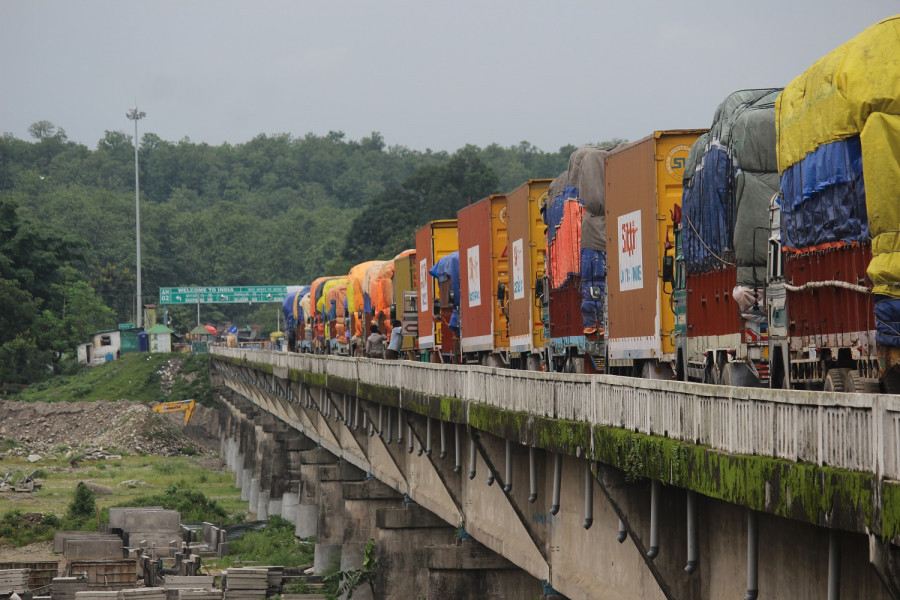Money
Nepal, India to amend bilateral transit treaty to expand trade and connectivity
A meeting of the Inter-Governmental Committee on Trade, Transit and Cooperation to Control Unauthorised Trade was held via video conference.
Krishana Prasain
Nepal and India on Monday agreed to amend the bilateral transit treaty in a bid to boost trade and connectivity during a meeting of the Inter-Governmental Committee (IGC) on Trade, Transit and Cooperation to Control Unauthorised Trade.
“As of now, only government-owned railway services transport cargo to Nepal, and under the proposed amendment, private operators will also be allowed to serve in Nepal,” said Baikuntha Aryal, secretary at the Ministry of Commerce and Supplies, who led the Nepali side at the meeting held via video conference.
“The amendment will also allow Nepali railway to be used for trade purposes. We had a comprehensive review of the transit treaty that includes the use of waterways and railway services between the two countries,” he said, adding that the date for signing the amended agreement was yet to be fixed as it had to be endorsed by the cabinets of the two countries.
The Indian side, led by Commerce Secretary Anup Wadhawan, included the Indian ambassador to Nepal Vinay Mohan Kwatra and a 15-member delegation from various ministries and the Indian Embassy in Kathmandu.
Aryal said that the meeting also focused on customs infrastructure for the promotion of trade.
According to the ministry, the Indian side announced that the construction of an Integrated Check Post (ICP) in Nepalgunj had already started, and that work on the facility in Bhairahawa would begin soon.
Nepal requested the Indian side to extend railway services up to the ICPs in Birgunj and Biratnagar, both of which were constructed with the support of the Indian government. “The Indian side agreed to discuss the issue with the concerned stakeholders,” the ministry said in a statement issued after the conclusion of the meeting.
The Indian delegation responded positively to Nepal's proposal for the construction of a dry port at Dodhara Chandani besides establishing an ICP and railway connection. The Nepali side agreed to prepare a detailed concept paper and a feasibility study of a cross-border economic zone in the Dodhara Chandani-Banbasa area.
According to the ministry, the Nepali side also requested its counterpart to allow Nepali traders to use Asian Highway 2 of India for trade with Bangladesh as the existing Phulbari-Banglabandha trade route had become congested.
The Indian delegation said that they would hold discussions with the authorities concerned and let Nepal know.
The Nepali and Indian delegations expressed happiness at the formation of a business forum of the private sectors of the two countries, and pledged to facilitate its first meeting by the first quarter of 2021.
The Nepali delegation raised the issue of anti-dumping charges and countervailing charges imposed by India on jute and jute related products.
As Nepali jute factories have been issued Indian ISI certification, the Nepali delegation also requested the Indian side to permit it to participate in the government procurement process like Food Corporation India. The Indian delegation responded positively, saying that it would take the matter up with the authorities concerned.
The meeting also decided to endorse the agenda including infrastructure, transit, trade and investment discussed at the joint secretary-level meeting held on December 3 and 4.
Both sides discussed the Motor Vehicle Agreement, quality and standard of commercial goods, and issues related to trade.
India is Nepal's largest trading partner, accounting for more than 65 percent of its total trade. According to the statistics of the Indian Department of Commerce, Nepal ranks among the top 10 export destinations for Indian goods.
In the last fiscal year, Nepal's import bill from India amounted to over $7 billion. Exports from Nepal to the southern neighbour totalled around $700 million, resulting in a huge trade deficit. Nepal is the 59th top import source for India.




 16.12°C Kathmandu
16.12°C Kathmandu













%20(1).jpg&w=300&height=200)
